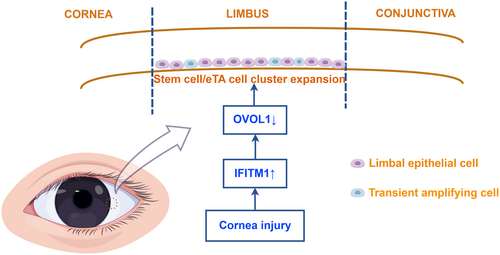Targeting the IFITM1/OVOL1 Axis for Treating Corneal Wounds
Web Published:
11/10/2025
NU 2024-159
INVENTORS
SHORT DESCRIPTION
This invention addresses corneal wound healing by providing methods and compositions to target the IFITM1/OVOL1 axis to modulate limbal epithelial stem cells (LESCs) and early transit amplifying cells (eTAs).

BACKGROUND
Maintaining corneal transparency and vision depends on the continuous regeneration of the corneal epithelium, a process critically reliant on limbal epithelial stem cells (LESCs) and their early transit amplifying (eTA) progeny. These cells are essential for repairing the cornea after injuries like chemical burns or physical trauma. However, the precise molecular mechanisms governing LESC activation and expansion remain incompletely understood, posing a significant challenge to effective corneal repair. This challenge is exacerbated in various pathological conditions, including diabetic keratopathy, dry eye disease, and age-related degeneration, where LESC function is often impaired, leading to defective epithelial regeneration and poor wound healing outcomes. The inherent difficulty in distinguishing and studying these phenotypically similar stem and early progenitor cells further complicates the development of targeted therapeutic strategies.
ABSTRACT
Northwestern researchers identified Interferon induced transmembrane protein 1 (IFITM1) as a protein that promotes LESC/eTA proliferation and expansion, while Ovo like zinc finger 1 (OVOL1) acts as a negative regulator of epithelial cell proliferation. Methods are provided for increasing IFITM1 expression or decreasing OVOL1 expression in the limbal epithelium, which activates LESCs and expands the stem/eTA population to enhance corneal repair. This modulation can be achieved using therapeutic agents, such as adeno-associated virus (AAV) vectors engineered to express IFITM1 or deliver siRNAs/shRNAs to reduce OVOL1, typically administered topically to the ocular surface.
APPLICATIONS
- Therapeutics for cornea regeneration – targeting the IFITM1/OVOL1 axis activates LESCs to treat a variety of corneal conditions, including acute injuries (e.g. chemical burns, physical trauma) and chronic diseases (e.g. limbal stem cell deficiency, diabetic keratopathy, dry eye disease).
ADVANTAGES
- Targeted activation of LESCs to promote corneal repair, as opposed to existing therapies requiring cultivated cells or donor tissue for transplantation.
- AAV approach offers a less invasive, more scalable, and more reproducible alternative to surgical interventions.
- Potential for broader patient applicability, including those unqualified for surgery.
- Safer profile compared to existing treatments that induce apoptosis or carry risk of immune rejection.
PUBLICATIONS
Jiang et al. IFITM1/OVOL1 Axis Is a Novel Regulator of the Expansion of the Limbal Epithelial Stem/Early Transient Amplifying Cell Population. FASEB J. 2025.
IP STATUS
A US non-provisional patent has been filed.
Patent Information:
| Title |
App Type |
Country |
Serial No. |
Patent No. |
File Date |
Issued Date |
Expire Date |
Categories:
Life Sciences > Therapeutics
Keywords: